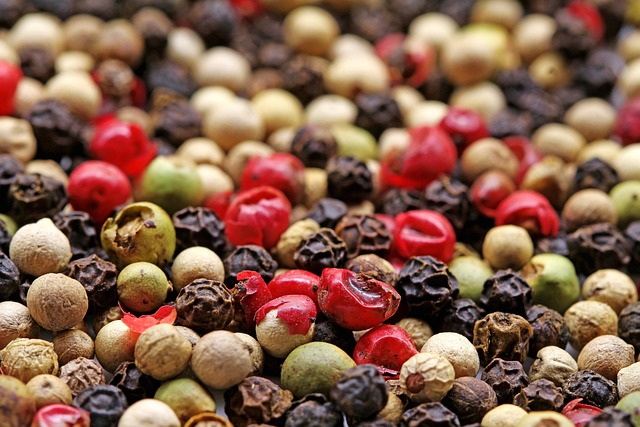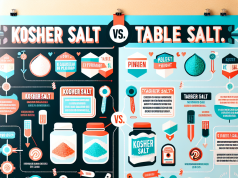Contents
Unveiling the Lesser-Known Culinary Uses of Brown and White Pepper
In this article, we will explore the many culinary uses of brown and white pepper that often go unnoticed. While commonly used as flavor enhancers or table seasonings, these two varieties of pepper can bring unique and delightful flavors to dishes when used creatively.
Brown Pepper:
Brown pepper, also known as black peppercorn, is the most widely used form of pepper. As it ripens, the pepper berries turn from green to yellow and finally to brown, which is when they are harvested and dried. Beyond its traditional role as a seasoning, brown pepper can be incorporated into various culinary preparations.
- Brown Pepper Marinade: Create a tantalizing marinade by combining brown pepper with other spices, garlic, citrus zest, and olive oil. This marinade adds complexity to meats, seafood, and even vegetables, infusing them with a subtle hint of warmth and spice.
- Brown Pepper Infused Oil: Infuse a neutral oil like olive or canola oil with brown pepper to create a versatile ingredient that can be used in dressings, sautés, or drizzled over dishes. The gentle heat and aromatic notes of the infused oil bring a delightful twist to your recipes.
- Brown Pepper Pickles: Take your homemade pickles to the next level by adding a few crushed brown peppercorns to the brine. This will give the pickles a unique and slightly exotic flavor, making them stand out among the usual homemade varieties.
White Pepper:
White pepper is derived from the same berries as black pepper, but it undergoes an additional step where the outer layer is removed to reveal the pale inner core. This process results in a milder and earthier flavor profile, making it ideal for specific culinary applications.
- White Pepper Cream Sauce: Elevate your cream sauces, soups, or creamy mashed potatoes by using white pepper instead of black pepper. The subtle heat and earthy undertones of white pepper blend harmoniously with creamy textures, creating a more refined taste experience.
- White Pepper Chocolate: Surprisingly, white pepper pairs wonderfully with dark chocolate. Grind a small amount of white pepper and sprinkle it over your rich chocolate desserts or incorporate it directly into the chocolate ganache, giving your treats a sophisticated touch.
- White Pepper Citrus Salad: Add a twist to your fruit salads by incorporating a pinch of white pepper. It adds an unexpected element that enhances the flavors of citrus fruits like oranges and grapefruits, balancing their natural sweetness with a gentle heat.
So, next time you reach for your trusty pepper grinder, consider the unique culinary possibilities that brown and white pepper can offer. Experiment with these lesser-known uses and let your creativity shine in the kitchen!
The Versatility of Brown and White Pepper in Culinary Delights
Introduction
Pepper, known as the ‘King of Spices,’ is a widely used ingredient in various cuisines around the world. While black pepper is the most commonly used type, both brown and white pepper have their own unique flavors and culinary uses. In this blog post, we will explore the lesser-known culinary uses of brown and white pepper, and how they can elevate the taste of your dishes.
Brown Pepper: A Distinctive Flavor Profile
While brown pepper is less known compared to its siblings, it boasts a distinctive and complex flavor profile. It is harvested when the berries are almost fully ripe, resulting in a deeper taste compared to black pepper. Here are some of its lesser-known culinary uses:
- Baking: Brown pepper can add a mild heat and earthy aroma to baked goods, such as bread, cookies, and cakes. It pairs well with spices like cinnamon and nutmeg, giving a unique twist to your sweet treats.
- Sauces and Marinades: The rich flavor of brown pepper is perfect for enhancing the taste of sauces and marinades. It can be a great addition to meat-based sauces, barbecue marinades, and even salad dressings.
- Gravies and Stews: Introducing brown pepper to gravies and stews provides a robust and warm undertone. It complements the flavors of slow-cooked meats and vegetables, making every spoonful a delight.
- Infused Oils and Vinegars: Create your own unique blends by infusing brown pepper into olive oil or vinegar. These infused concoctions can be used to dress salads, drizzle over roasted vegetables, or even as a dipping sauce for crusty bread.
White Pepper: Mild Heat, Subtle Flavor
White pepper, on the other hand, offers a milder heat and a more subtle flavor compared to black pepper. It is made from fully ripened pepper berries with the outer skin removed. Let’s discover its lesser-known culinary uses:
- Soups and Creamy Dishes: White pepper can add a peppery warmth without altering the color of light-colored soups, creamy sauces, or mashed potatoes. Its mild flavor ensures it doesn’t overpower the other ingredients.
- Seafood: Enhance the delicate flavors of seafood dishes like shrimp scampi or grilled fish by incorporating white pepper. Its subtle heat allows the natural sweetness of the seafood to shine through.
- Eggs and Cheese: Sprinkling a pinch of white pepper onto scrambled eggs, omelets, or cheesy dishes adds a pleasant spiciness that elevates the overall taste. It pairs exceptionally well with dishes containing Parmesan or Gruyère cheese.
- Asian Cuisine: White pepper is a staple in many Asian cuisines, especially Chinese and Thai. It is used in stir-fries, soups, and sauces, providing a unique flavor dimension to these dishes.
If you want to learn more about the various types of culinary peppers, check out our detailed blog post on the different types of peppers and their flavors.
In Conclusion
Brown and white pepper might be less commonly used than black pepper, but they have their own distinctive flavors and culinary applications. By incorporating these lesser-known peppers into your cooking, you can take your dishes to a whole new level and surprise your taste buds with exciting flavors. Experiment with these forgotten gems and uncover a world of culinary delights!
Frequently Asked Questions:
What are the culinary uses of brown and white pepper?
Brown and white pepper are widely used spices in cooking and can add an extra kick of flavor and aroma to various dishes. Some common culinary uses include:
- Seasoning soups, stews, and sauces
- Marinating meat, poultry, and seafood
- Enhancing the flavors of vegetables and stir-fries
- Adding a spicy touch to pasta and rice dishes
- Creating flavorful rubs and spice blends for grilling and roasting
What is the difference between brown and white pepper?
Brown and white pepper come from the same peppercorn plant, but the main difference lies in their processing:
- Brown pepper is made from fully ripened black peppercorns. The outer layer is allowed to dry and is then removed, revealing the brown inner seed.
- White pepper, on the other hand, is made from ripe peppercorns that have been soaked in water to remove the outer layer before drying. This gives it a milder flavor compared to brown pepper.
Can brown and white pepper be used interchangeably?
Yes, brown and white pepper can usually be used interchangeably in recipes. However, it’s important to note that white pepper has a milder taste and can be a better choice if you want to avoid the visible black specks in light-colored dishes. For recipes where the visual appearance is not a concern, either type can be used based on personal preference.
How should brown and white pepper be stored?
To maintain their flavor and potency, both brown and white pepper should be stored in airtight containers away from direct sunlight and heat. It is best to keep them in a cool and dry place, such as a pantry or spice cabinet.
Are there any health benefits to consuming brown and white pepper?
Both brown and white pepper contain compounds that have been associated with potential health benefits. They are believed to have antioxidant properties and may aid digestion. However, it’s important to consume them in moderation and consult a healthcare professional if you have any specific health concerns.
Brown White Pepper: A Staple Spice for Every Culinary Enthusiast
What is Brown White Pepper?
Brown white pepper is a type of pepper that has a unique flavor profile and is widely used in various cuisines around the world. It is derived from the same plant as black and white pepper, but undergoes a different preparation process, resulting in its distinctive color.
The Versatility of Brown White Pepper
With its rich and mildly pungent taste, brown white pepper adds depth and complexity to a wide range of dishes. It is commonly used in savory recipes such as soups, stews, marinades, sauces, and curries. The spice blends perfectly with both meat and vegetable dishes, making it a go-to ingredient for many chefs and home cooks.
The Difference between Brown White Pepper and Black Pepper
Many people wonder how brown white pepper differs from black pepper. While both come from the same pepper plant (Piper nigrum), the difference lies in the way they are processed. Black pepper is harvested when the berries are fully mature and then sun-dried, resulting in its characteristic dark color. On the other hand, brown white pepper is harvested just before full maturity and is processed differently to retain its lighter hue while still being flavorful.
Health Benefits of Brown White Pepper
Brown white pepper not only enhances the taste of your dishes, but it also offers several health benefits. It contains a compound called piperine, which may aid digestion, promote nutrient absorption, and possess anti-inflammatory properties. Additionally, it is a good source of vitamins and minerals, including vitamin C, manganese, and iron.
Where to Use Brown White Pepper?
The applications of brown white pepper are endless. Sprinkle it over roasted vegetables, add it to creamy pasta sauces, or use it as a seasoning for grilled meats to elevate the flavor. Its versatility extends to beverages as well, with some enjoying a pinch of brown white pepper in their hot chocolate.
If you want to learn more about the fascinating world of different pepper varieties, feel free to visit the Pepper page on Wikipedia.
Unveiling the Lesser-Known Culinary Uses of Brown and White Pepper
Introduction
- Brief overview of the significance of brown and white pepper in cooking
Brown Pepper Culinary Uses
- Enhances the flavor of grilled meats and vegetables
- Perfect ingredient for marinades and dry rubs
- Adds depth to soups, stews, and sauces
- Gives a unique twist to savory baked goods
White Pepper Culinary Uses
- Commonly used in creamy and light-colored dishes
- Ideal for flavoring mashed potatoes and creamy sauces
- Enhances the taste of seafood and fish
- Provides a subtle heat in Asian cuisine








































